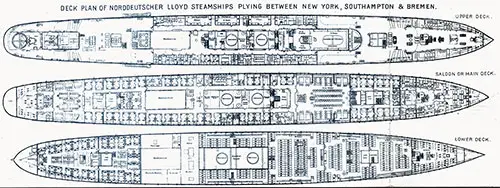The Short Route to London (1889): A North German Lloyd Brochure on Luxury Ocean Travel and Global Routes
📌 Explore the 1889 North German Lloyd brochure detailing the short route to London. A vivid primary source showcasing ocean liner accommodations, global steamship routes, and Victorian-era travel, ideal for genealogists, historians, and educators.
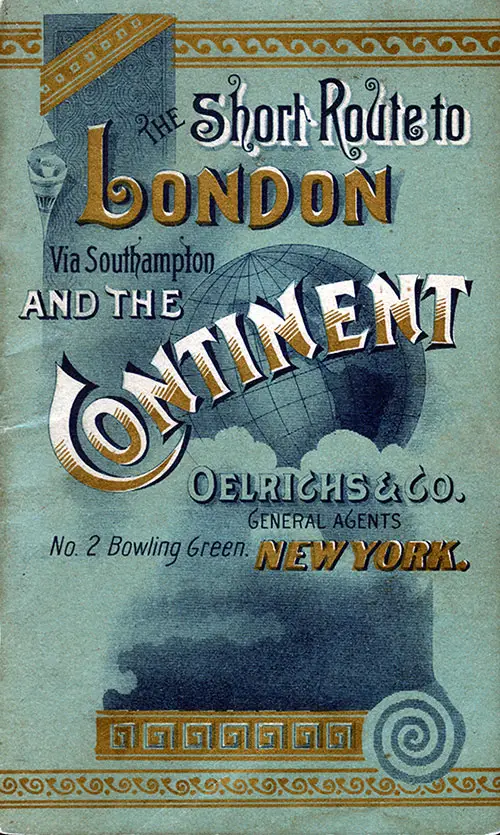
Front Cover of 1889 Brochure from North German Lloyd "Short Route to London via Southampton and the Continent." Published by Oelrichs & Co., General Agents of Nordeutscher Lloyd in New York. | GGA Image ID # 11f29e2a1e
🛳️ Elaborate Review & Summary: The Short Route to London via Southampton and the Continent — North German Lloyd, 1889
🎓 “A 19th-Century Ocean Travel Brochure Turned Educational Goldmine”
📘 Overview
The 1889 North German Lloyd (NDL) brochure titled "The Short Route to London via Southampton and the Continent" is more than a promotional travel pamphlet—it is a remarkable cultural artifact that opens a window into late 19th-century transatlantic steamship travel. Created during the Paris Exhibition of 1889, this richly detailed guide was distributed by Oelrichs & Co., the line’s New York agents, and served as both a functional passenger handbook and a marketing showcase for NDL’s first and second cabin services.
Teachers, students, genealogists, and historians will find the brochure incredibly valuable for understanding the social, economic, and technological structures of the Gilded Age’s oceanic travel system.
This brochure was created by New York Agents of the North German Lloyd Bremen Steamship Line in 1889, the year of the Paris Exhibition. As a convenient pocket-size guide, the brochure provided helpful information about the Norddeutcher Lloyd, its fleet, and accommodations for First and Second Cabin passengers.
North German Lloyd Fleet
The Company's Fleet of Fast Express Steamers on the New York Line, Consists of the following Magnificent Steamships: Lahn, Eider, Trave, Aller, Ems, Fulda, Saale, Werra, and the Elbe Of 5,000 to 6,000 Tons & 8,000 to 10,000 Horse-Power.
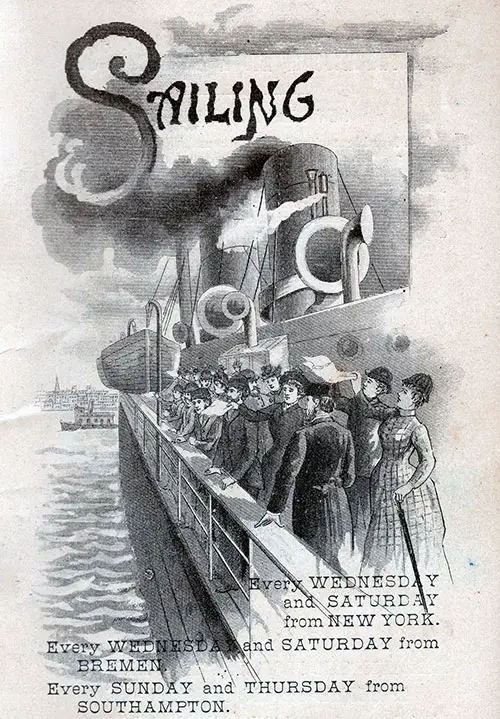
Passengers Leaving Port Wave Farewell to the Crowds on the Pier on Sailing Day. (Norddeutscher Lloyd) | GGA Image ID # 11f2bc9b97
Sailing Every Wednesday and Saturday from New York. Every Wednesday and Saturday from Bremen. Every Sunday and Thursday from Southampton.
Extra Steamers during the Travelling Season. Steamers between Southampton and Havre will sail daily during the Paris Exposition.
New York Express Line
The Norddeutscher Lloyd Steamship Company maintains a service twice a week between Southampton and Bremen, with extra sailings during the traveling season.
Steamers leave New York every Wednesday and Saturday, and passengers land in Southampton less than 7½ days after leaving New York.
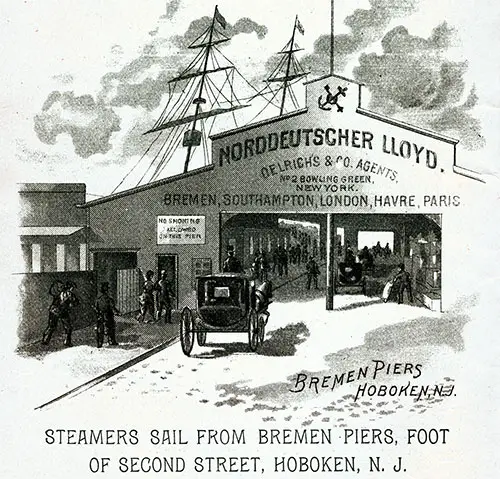
Steamers Sail from Bremen Piers, Foot of Second Street, Hoboken, NJ. (Norddeutscher Lloyd) | GGA Image ID # 11f2f55c15
Hoboken can be reached from New York by the Barclay St. (downtown) or Christopher St. (uptown) Ferries, which land passengers at the same slip in Hoboken, about 5 5-minute walk from the Bremen steamers.
London is reached by rail from Southampton in about 2 hours by Special Norddeutscher Lloyd Trains and cars. Trains leave and arrive at Waterloo station in London.
After landing passengers, mail, and luggage at Southampton, the steamers proceeded immediately to Bremerhaven (the harbor of the Norddeutscher Lloyd fleet). The trip lasts about 24 hours.
Passengers are transferred to the railway train waiting on the quay at Bremerhaven, which will take them to Bremen in hours.
Bremen is a railway center that frequently communicates directly with the interior of Germany, Switzerland, Austria, etc.
Paris is reached in 8 hours from London via Dover and Calais and Southampton and Le Havre in about 12 hours. Southwestern Railway Co.’s steamers leave Southampton for Le Havre, and vice versa, every Monday, Wednesday, and Friday evening: in the summer, daily. The Le Havre steamers leave from the landing dock at Southampton.
Other Norddeutcher Lloyd Lines
The Other Lines of the Norddeutscher Lloyd Steamship Co. Ply Between the Following Ports:
Baltimore Line
From Bremen to Baltimore, weekly, except during the winter months.
Brazil Line
From Bremen, via Antwerp, Lisbon, Bahia, Rio de Janeiro, and Santos, monthly steamers.
Buenos Aires or River Plate Line
From Bremen via Coruna, Vigo, Montevideo, and Buenos Aires, fortnightly steamers.
China Line
From Bremen, via Antwerp, Southampton, Genoa, Port Said, Suez, Aden, Colombo Singapore, Hongkong and Shanghai, monthly steamers.
Australian Line
From Bremen, via Antwerp, Southampton, Genoa, Port Said, Suez, Aden, Colombo, Adelaide, Melbourne and Sydney, monthly steamers.
Japanese Branch Line
In Hong Kong, steamers run via Yokohama, Hyogo, and Nagasaki in connection with the China Line.
Branch Line to Samoa, and Tonga Islands, South Pacific
Sydney to Tonga and Samoa Islands run in connection with the Australian Line.
Mediterranean Line
Brindisi to Port Said, which connects with China and the Australian Line.
Passengers are booked from New York using any of the lines mentioned above.
Description of Steamers
The fast Express Steamers of the Norddeutscher Lloyd running on the New York Line were all built by John Elder & Co. (now the Fairfield Shipbuilding and Engineering Co.), Glasgow, Scotland. The steamers are very similar in their interior and exterior arrangements and fittings.
These steamers, built of iron and steel, are the largest and most modern types. They are classed in the highest grade of the Bureau Veritas, with several extras over the requirements, such as lower and orlop decks of iron and steel and additional water-tight bulkheads.
The highest care and attention have been bestowed upon the construction of compartments and water-tight bulkheads. The efficiency of these safeguards has been amply proved by filling each compartment with water and thus testing the strength of the bulkheads in case of an accident.
The steamers are fully equipped with lifeboats, rafts, and preservers and have every improvement conducive to safety and comfort.
All the deck work is constructed of teak or iron and steel, and to protect the vessels from the heavy Atlantic seas, solidly built turtlebacks are placed over both ends of the ship.
The steamers are rigged with iron four-pole masts, carrying yards on the foremast only. Due to their powerful engines, these steamers can maintain a high rate of speed in nearly all weather and thus arrive with great regularity.
Berths and Staterooms
When contemplating a trip across the ocean, the tourist or businessman should apply immediately for accommodations on the steamer he has selected.
During the entire spring and summer season, the steamer's cabins are all well-filled, and it is necessary to apply early for passage if one wishes to enjoy the luxuries of a good room.
Plans and diagrams showing the interior arrangements of the various steamers are always kept on hand and will be sent on application.
It is customary to pay a deposit of $25 on each berth retained. This payment secures the berth up to two weeks before the sailing, when the full amount of passage must be paid and tickets are taken up.
First Cabin
Children under 12 years are taken for half rate if occupying a sofa and not a regular berth. Rooms are not sold for less than two fares during the traveling season. One person desiring a stateroom for exclusive use will be charged for two.
Infants under 1 year are free. Servants are berthed in the second cabin and pay the second cabin fare, with access to the first cabin. If berthed in the first cabin, they pay the full first cabin fare.
Second Cabin
Children under 12 are taken for half fare at all times without restriction, and infants under 1 year are free.
Baggage
AVOID overloading with unnecessary articles and packages, only taking what is necessary. Cabin passengers are allowed twenty cubic feet of luggage.
All travelers should provide themselves with sea trunks, which should be about 12 inches deep and of the usual width and length. This will enable them to go under the sofas in the stateroom. Avoid the Saratoga or extra-large trunks.
Passengers can send their baggage to Bremen Piers, Hoboken, N.J., two days before sailing. It will be kept in the baggage room until the passengers' arrival.
All baggage must be marked with the passenger's and steamer's names before being sent. If this precaution is not observed, the Company cannot be responsible for mistakes.
All baggage should also be marked, whether for stateroom or baggage room, before being sent to the steamer. Tags and labels can be obtained at the Company's office or from its agents.
All baggage required during the voyage should be marked "Wanted," and luggage that is not needed should be labeled "Not Wanted."
Extra Baggage 25 Cents a Cubic Foot
Sea trunks can be stored at Southampton or Bremen, but the names should be marked. Passengers should notify the Company at Bremen or the Agents at Southampton, as the case may be, at least five days before sailing to put sea trunks on board. When passengers do not attend to this correctly, it causes delays and extra expenses for the passenger.
Passengers arriving in New York from out of town can have their baggage checked at the pier by the Baggage Express Agent on the train.
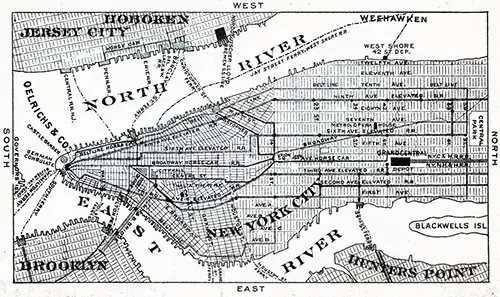
Map of the Norddeutscher Lloyd Pier in Hoboken, NJ. (Norddeutscher Lloyd) | GGA Image ID # 11f5ab5e2d
Passports
Passports can be obtained by applying to the State Department, Passport Division, Washington, D. C., or through a Notary Public.
Letters of Credit
If the traveler's expenses are substantial, a circular letter of credit is undoubtedly the only safe way of transporting the money. Bankers issue these circular letters of credit to their correspondents in Europe and all over the world, and funds can thus be obtained at any one of the principal cities of the civilized world. Tourists should be careful to deal only with bankers who have undoubted standing.
Money
Before embarking for Europe, travelers would do well to provide enough small change to pay incidental expenses on shipboard and landing. Foreign currency is bought, sold, or exchanged at current rates of the day at any banking house.
It may be well to add that English sovereigns and Bank of England notes are readily taken everywhere in Europe. French Napoleons are also good money, especially in the East.
Miscellaneous
Surgeons: Each steamer carries an experienced surgeon whose services are gratuitous for steerage passengers. Cabin passengers generally expect to pay the doctor whenever he prescribes for them.
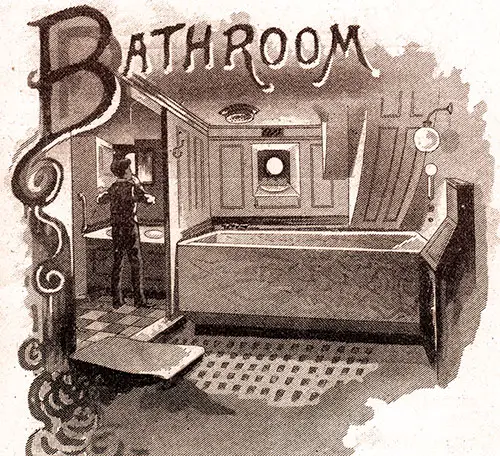
A Well-Equipped and Elegant Bathroom. (Norddeutscher Lloyd) | GGA Image ID # 11f4e2d323
Baths—By applying to your bedroom steward, these can be arranged, and a certain hour can be appointed when you can take a bath every morning if you desire to do so.
Boots. If passengers leave their boots and shoes outside the room door, the bootblack will clean them. Each person generally gives the bootblack a small gratuity at the end of the voyage.
The chief steward allocates tables after the steamer leaves the dock. Children are not allowed at the table until all adult passengers have been seated. They generally have their meals served separately.
Valuables
The purser is authorized to custody money, jewelry, and other valuables, for which a safe is provided.
Paper, Envelopes, Stamps, Etc.
Writing paper, envelopes, stamps, and telegraph forms can be had on application of the saloon steward.
Deck Plan of Norddeutscher Lloyd Steamships Plying Between New York, Southampton, and Bremen. (Norddeutscher Lloyd) | GGA Image ID # 11f58d059d
Travel In Europe
American travelers who visit Europe for the first time cannot fail to be struck by the forcible contrast in the railroad system, especially with the difference between our cars and those running there.
In almost every European country, there are three classes of cars, viz. : first, second, and third. Express trains on the Continent have no third-class and, in many cases, are formed exclusively of first-class coaches.
First class is best for long journeys, and we do not recommend second class, except in Germany, Austria, and Switzerland. The cars in these countries are of entirely different construction from those in America. Each vehicle is generally divided into four compartments, which are entered at each end through a door on the side of the carriage.
The different classes are distinguished by having the class marked on the outside of the doors and occasionally on the inside, namely first, second, and third class so that travelers can readily recognize where to locate.
Ladies traveling alone will generally find a compartment specially reserved for them. A smoking carriage will be found on almost every train. Sleeping cars are to be found in many English and Continental railways.
Pullman cars run in Great Britain and on the Continent; an early application must be made for accommodation when required. Coupes are also used, and places can be secured by paying a supplemental fee at the station on departure. Railway officials, as a general rule, will be very courteous and willing to assist travelers whenever the occasion arises.
Norddeutscher Lloyd Steamship Co.
ORDERS to report the arrival of steamers of this line should be left with the Western Union Telegraph Company at any of their offices; on the arrival of the ship off Fire Island or Sandy Hook, notice will then be sent by the W. U. Tel. Co., day or night, to the address given.
Quarantine - Health Examinations
Steamers of this line usually run from Fire Island to Quarantine in about 3 hours or from Sandy Hook to Quarantine in about one hour.
The usual time from Quarantine, including the examination by the Health Officer, to the pier is about one hour. Still, if steamers arrive at Quarantine after sunset, they must remain there until sunrise the next morning.
Cabin passengers arriving by steamers of this line are landed at the Company's piers, foot of Second Street, Hoboken, NJ (Take Christopher Street ferry from up-town or Barclay Street ferry from downtown )
Persons desiring to meet arriving Cabin passengers require no pass to admit them on the pier.
Passengers and their friends on engaging carriages outside of the pier should ask for the tariff to avoid an overcharge on the part of hackmen, with which each hack must be supplied.
Letters
LETTERS for passengers should be plainly addressed and state whether they are for an arriving or departing steamer. Passengers expecting messages after departure should leave their addresses at the Company's offices. Letters will then be forwarded to the address given.
Envelopes should be plainly marked with the sender's name and address to ensure the return of letters in case of non-delivery. Letters not so provided are returned to the dead letter office, and as the Post Office has no clue to the sender, they are destroyed.
Return Tickets
Although there is no reduction on First Class return tickets, we would strongly advise First Cabin passengers who intend to return by the Norddeutscher Lloyd Steamers to engage accommodations for the return voyage when engaging staterooms for outward passage, or as soon thereafter as possible and so settle for return passage when taking up outward tickets.
Thus, passengers will avoid delays in extended correspondence with the Home Office and will not be disappointed that the best rooms have already been sold.
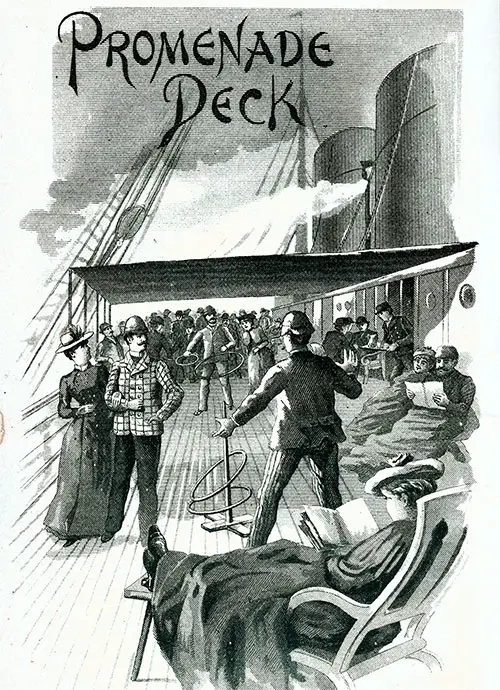
Passengers Relax on the Promenade Deck of a North German Lloyd Steamer. (Norddeutscher Lloyd) | GGA Image ID # 11f2f60481
Promenade Deck
The Promenade Deck is situated in the center of the tipper deck in the most favorable position on the steamer. It is 200 feet long and the whole width of the ship. It is solely appropriated for the use of the first cabin passengers.
Being on an elevation with the turtle and hurricane decks and sheltered by awnings, the hottest days are rendered pleasant by the free access of the ocean breeze. Thus, the promenade forms an excellent and spacious playground for the various sports arranged for passengers' pastime and otherwise contributes mainly to the comfort and enjoyment of an ocean trip.
It is illuminated at night by electric lights. At certain hours, the promenade deck also furnishes the space for concerts executed by the ship's orchestra daily.
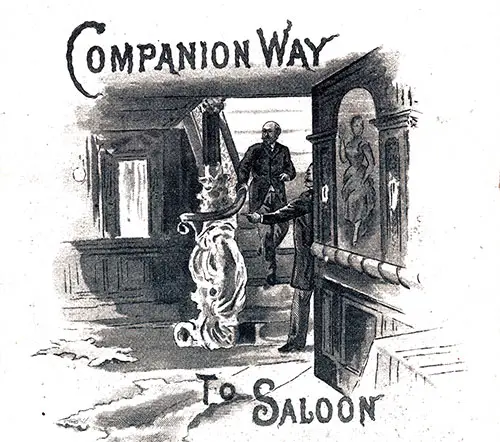
A Companionway to the Dining Saloon. (Norddeutscher Lloyd) | GGA Image ID # 11f32e0f79
Companion Way to Saloon
The wide staircase, handsomely ornamented with plush handrails and balusters of rich and fanciful pattern, leads down into the first cabin saloon. It opens to a region of exquisite splendor and corn-fort, which is rarely seen and almost baffles description.
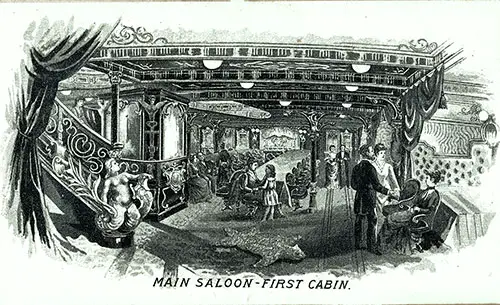
First Cabin Main Saloon on a North German Lloyd Steamship. (Norddeutscher Lloyd) | GGA Image ID # 11f35cbee5
Description of Saloon
The main saloon of the first cabin is situated amidships, forward of the boilers and engines. Old and experienced ocean travelers consider this the most favorable position on the ship.
Occupying the entire width of the steamer and proportionate in length, it presents a truly magnificent appearance. It is splendidly lighted and perfectly ventilated, employing large skylights in the center and numerous portholes along the side.
Two long main tables occupy the central position, running nearly the entire length of the saloon. The sides are subdivided into cozy alcoves or recesses, which are furnished with smaller cross tables, excellently adapted for the accommodation of private parties or families.
All the fittings, including the piano, bookcases, doors, ceilings, skylights, and the woodwork of the revolving chairs surrounding the tables, are handsomely carved. The materials used are Oak, Black Walnut, bird's-eye Maple, Ebony, and other costly woods.
The table covers and heavy curtains dividing the alcove, the lounges extending along both sides under the portholes, and the chairs' seats are made of luxurious plush or other sumptuous materials, differing in color to harmonize with the particular style of the woodwork on the various steamers.
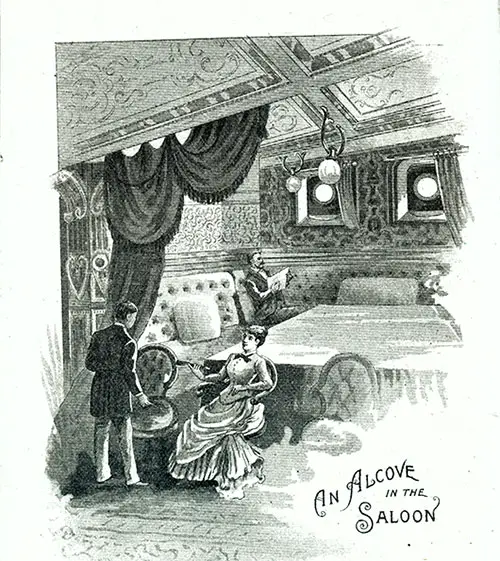
An Alcove in the Dining Saloon. (Norddeutscher Lloyd) | GGA Image ID # 11f3bc5950
The highly ornamental skylights and ceiling are marvels of artistic skill and taste. The cross-beams, trusses, and framing, covered with magnificent scrollwork, are subdivided into panels, embellished with beautiful paintings by celebrated masters, and are really worth a close inspection.
The electric lights and the plate glass mirrors are arranged to increase the harmonious effect during the day and intensify it at night.
The company has discarded the traditional swinging racks used for glasses and decanters above the tables on all its steamers, thus leaving the view entirely free and unobstructed and significantly improving the saloon's general appearance.
Owing to the powerful triple expansion engine and the saloon's favorable position, it is hardly possible for the occupants to experience the ship's motion. It is challenging to realize that the vessel is traversing the high sea at a rate of eighteen knots an hour, so remarkably steady is the progress of these elegant modern express steamers.
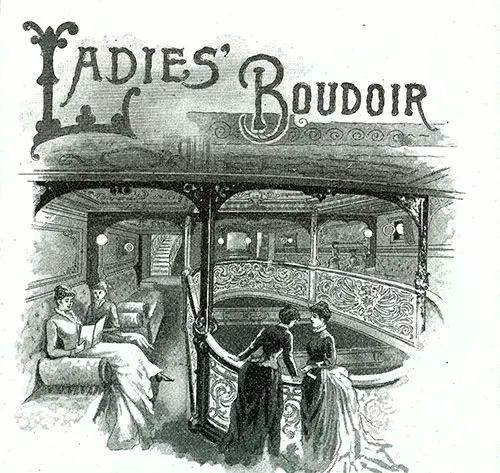
Women Can Relax and Socialize in the Ladies' Boudoir. (Norddeutscher Lloyd) | GGA Image ID # 11f3c078da
Ladies' Boudoir
The ladies' cabins are even more luxurious in their appointments, as no expense has been spared to contribute to these boudoirs' artistic appearance or absolute comfort.
The upper deck has perfect ventilation and forms a gallery to the main saloon beneath. The comfortable chairs and divans are provided with luxurious coverings of embossed velvets and plushes. They are specially designed for ease and comfort.
The walls and ceilings are elaborately carved and decorated with exquisite paintings.
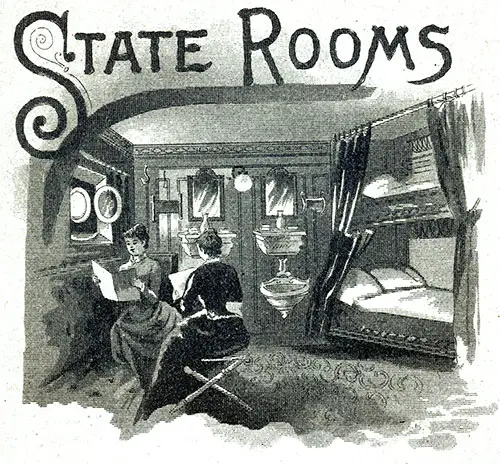
First Class Staterooms on the North German Lloyd Steamer. (Norddeutscher Lloyd) | GGA Image ID # 11f418a0fe
Staterooms
On the same deck as the saloon, running fore and aft of it, are the staterooms for first-cabin passengers. They are spacious, airy, and comfortable, painted white enamel, with walnut fittings.
They are all designed in large dimensions, measuring, on average, ten feet in breadth. Nearly all outside rooms have large sidelights or portholes, making them pleasant resorts for those who seek seclusion.
The lower berths in most staterooms are arranged to be extended to form double berths and accommodate two people.
The upper berth can be pushed back (like an upper berth in a Pullman car) out of the way. The sofas are wide and large enough to be used as beds if required; thus, a whole family frequently finds one of these rooms ample for their needs.
All staterooms are furnished with toilet conveniences, and electric bells communicate with the steward's department, ensuring prompt service.
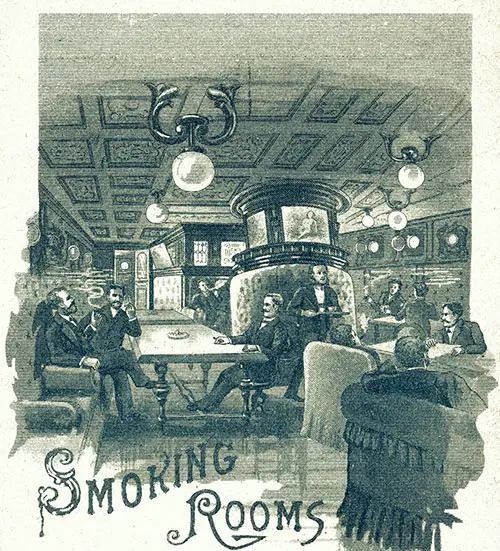
Gentlemen Socializing in the Elegant Smoking Rooms Onboard the Steamers. (Norddeutscher Lloyd) | GGA Image ID # 11f42550fa
Smoking Rooms
Two elegantly appointed smoking rooms, both located on the promenade deck, are provided for first-cabin passengers. They are constructed on the same lavish scale.
The paneling is finely carved and decorated with paintings that are artistically introduced here and there. Several small tables and divans covered with Morocco leather and a liberal supply of exceedingly comfortable armchairs covered with the same material make a cozy nook for after-dinner coffee.
The room also includes a small bar to supply the refreshments required by its frequenters.
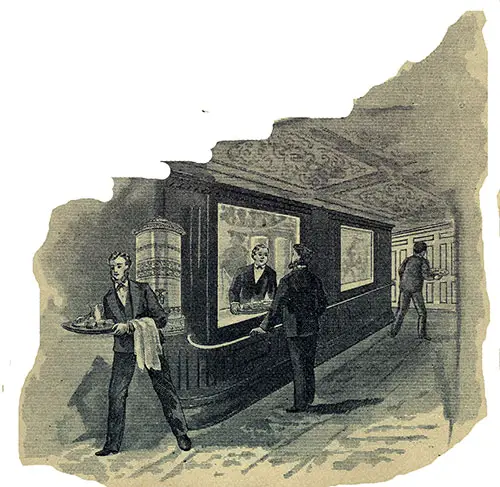
Waiters Pick Up Food from the Kitchen to Deliver to Their Guests. (Norddeutscher Lloyd) | GGA Image ID # 11f43c55d4
Cuisine
The reputation of the Cuisine on board the Norddeutscher Lloyd steamers is duly established and has been well earned by the untiring exertions of the management to supply an excellent table and to engage the foremost and best culinary artists to be procured as cooks.
Passengers are furnished with a liberal table, including all the season's delicacies, prepared and served equal to the menu in Europe's best hotels. Connoisseurs have pronounced the fare on these steamers as most excellent.
The company carefully selects exceptional wines, liquors, and cigars sold onboard at extremely moderate prices.
The galleys and kitchens are on deck, and the pantries, immediately beneath them, are connected by elevators, successfully preventing kitchen odors from entering the saloon or staterooms.
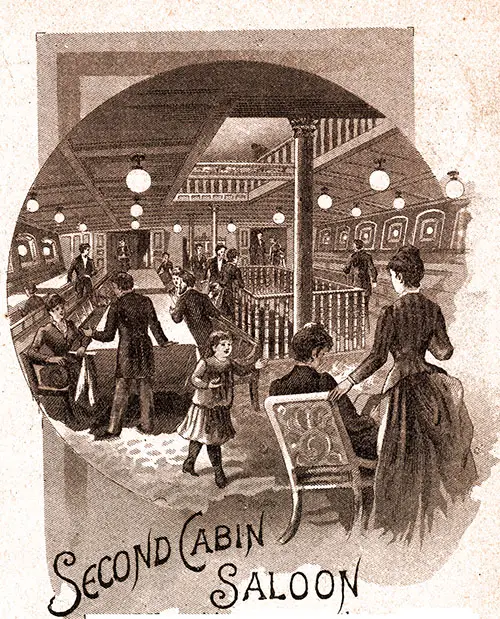
A Comfortable, Spacious Second Cabin Dining Saloon. (Norddeutscher Lloyd) | GGA Image ID # 11f44b7cf9
Second Cabin Saloon
Every provision is made for the comfort and well-being of the second cabin passengers; the accommodations compare favorably with those of the first cabin of bygone days. Both saloons and staterooms are located aft.
The saloon is thoroughly ventilated and lighted utilizing large skylights and portholes similar to those of the first cabin. While not so ornamental, it is fitted out exceedingly tastefully, offering every convenience that can be desired.
The furniture, which is richly upholstered and constructed for ease and comfort, includes a piano provided exclusively for the use of the second cabin passengers.
Electric lamps furnish the necessary light at night. The fare is equal to that of a first-class household. Efficient and attentive stewards serve it at certain regular hours. Wine and beer are supplied at meager prices without affecting the quality, being selected by the Company with great care.
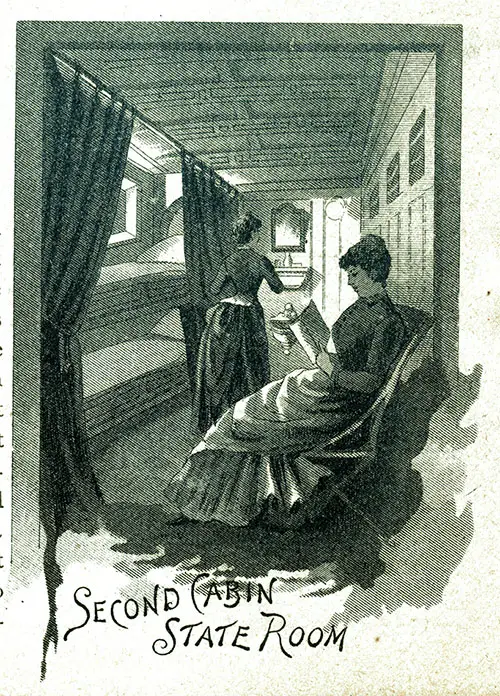
A Cozy Second Cabin Stateroom. (Norddeutscher Lloyd) | GGA Image ID # 11f46d2c09
The staterooms are also situated aft and close to the saloon. They are spacious, well-lighted, and ventilated apartments containing every desirable convenience and can accommodate two to four persons. Special care is taken to provide the berths with clean and neat bedding.
Two stewardesses, detailed especially for that purpose, attend to the needs of the lady passengers. The Ladies' Boudoir has an excellent position on the upper deck and is cozily furnished with elegantly upholstered chairs and settees. Because of its splendid location, it receives plenty of light and fresh air.
The Gentlemen's Smoking Room is also advantageously situated on the upper deck and is comfortably furnished with easy chairs and lounges covered with embossed leather. The stewards in attendance serve wine and beer.
Electric lamps light it night and serve as a pleasant resort for smokers to pass the evening hours.
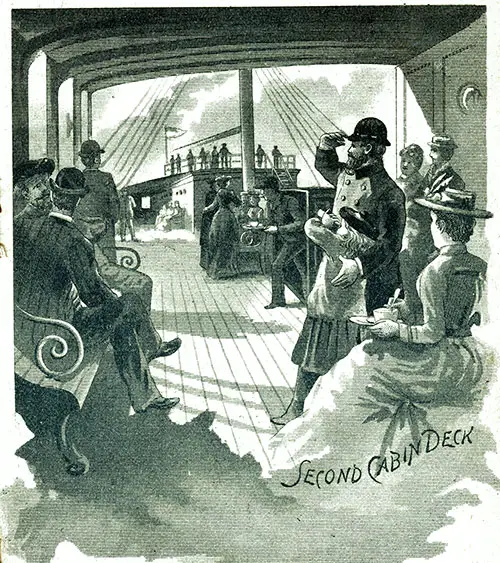
The Second Cabin Deck on Norddeutscher Lloyd. (Norddeutscher Lloyd) | GGA Image ID # 11f48e0977
Ample deck space has been set aside for the special use of second cabin passengers, and as will be seen by the illustration above, it affords ample opportunity to indulge in a promenade or a quiet rest in a well-sheltered position.
Thus, passengers can enjoy the fresh sea air without being exposed to high winds. This is a strong feature of our second cabin, the benefits of which cannot be overestimated.
Officers
The steamers are commanded by experienced officers who have become veterans of the Company's service and whom the Company implicitly confides in.
The Norddeutscher Lloyd Steamship Company officers are obliged to pass two rigorous examinations in the German nautical schools before they can obtain a position in the Company's service.
All of them have begun their career before the mast and have worked their way, step by step until they have proved themselves worthy of the trust placed in their hands by the Company.
The most conspicuous examples of devotion to duty and strict attention to the Company's interest are rewarded by a well-regulated promotion system, thus ensuring that those who distinguish themselves in the qualities most desirable in a seaman have a sure prospect of advancement.
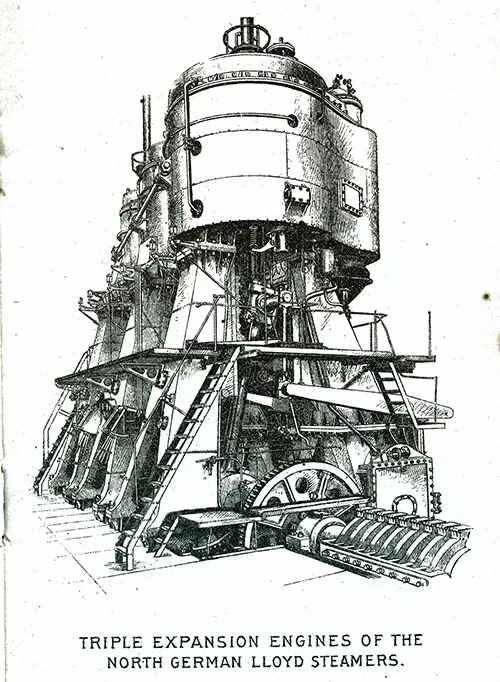
Triple Expansion Engines of the North German Lloyd Steamers. (Norddeutscher Lloyd) | GGA Image ID # 11f4b012a1
The Crew of a Steamship
Each steamer is manned by about 200 men, who are divided as follows: 36 deckhands under four officers and 10 petty officers, 60 firemen, coal-heavers and machinists under 15 engineers, and 75 stewards.
Foreign Agencies
- KELLER, WALLIS & Co., 32 Cockspur St., Charing Cross, London.
- KELLER, WALLIS & CO., Southampton.
- LHERBETTE, KANE & Co., . . 19 Rue Scribe, Paris.
- LHERBETTE, KANE & CO., . . . . . Havre
Company's Offices: BREMEN, Germany.
- OELRICHS & CO., General Agents, No. 2 BOWLING- GREEN, W YORK.
- H. CLAUSSENIUS & CO., General Western Agents, 2 SOUTH CLARK ST., CHICAGO.
List of Foreign Gold, Silver and Bank Notes
Their equivalent in American money, intrinsic value, without regard to the exchange rate.
Great Britain
GOLD.
- One Sovereign, $4 86
- One-half Sovereign, $2.43
SILVER.
- Crown, $1 20
- One-half Crown, $0.60
- One Florin, $0.48
- One Shilling, $0.24
- Six Pence, $0.12
- Four Pence, $0.08
- Three Pence,$0.06
BANK NOTES.
- £ 5 Bank of England, $24.25
- £ 1 Irish and Scotch, $4.84
Germany
GOLD.
- Twenty Marks, $4.74
- Ten Marks, $2.37
- Five Marks, $1.18
SILVER.
- One Thaler, $0.69
- One Mark, $0.23
BANK NOTES.
- One Hundred Marks, $23 62
- Fifty Marks, $11.81
- Twenty Marks, $4.72
- Five Marks $1.18
Mexico
- Silver Dollar, $0 73
- Gold Doubloon, $15.55
- Gold, $19 55
France, Belgium, and Switzerland
GOLD
- Twenty Francs, $3 86
- Ten Francs, $1 93
- Five Francs $0.96
SILVER.
- Five Francs, $ 0.93
- Two Francs $0.36
- One Franc $0.18
- 1/2 Franc (50 Centimes), $0.09
BANK NOTES.
- Fifty Francs, $9 62
- One Hundred Francs, $19.12
- Five Hundred, $95.60
- One Thousand, $191.20
Spain
GOLD.
- Four Piasters, $3.88
- Pistole, $3.87
- One half Pistole, $1.93
- One quarter Pistole, $0.95
SILVER.
- Spanish Dollar, $0.75
- Five Pesetas, $0.80
- Twenty Reals, $0.75
- Ten Reals, $0.37
- Pistareen, $0.16
- Half Pistareen, $0.08
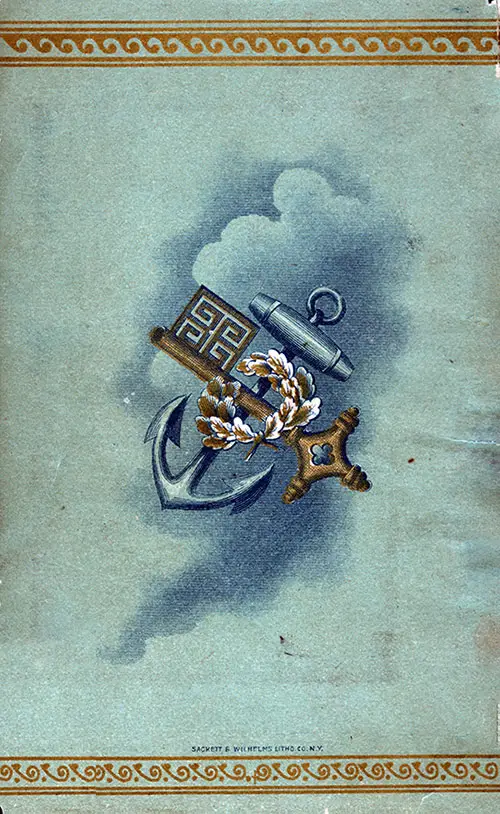
Back Cover of 1889 Brochure from North German Lloyd "Short Route to London via Southampton and the Continent." (Norddeutscher Lloyd) | GGA Image ID # 11f5b2f249
Brochure Information
- Title: The Short Route To London via Southampton And The Continent
- Published by: Oelrichs & Co. General Agents, Norddeutscher Lloyd
- Date Published: Undated (1889 - due to reference to the Paris Exhibition)
- Number of Pages: 32
- Dimensions: 9.2 x 15.1 cm
🚢 Key Highlights of the Brochure
⚓ The Fleet and the “Short Route”
The brochure introduces NDL’s Express Steamers (Lahn, Trave, Ems, Werra, etc.), boasting 5,000–6,000 tons and 8,000–10,000 horsepower, offering a “short” transatlantic route:
- New York → Southampton (in under 7.5 days) → London (via special train)
👉 For genealogists, this clarifies port sequences and transport logistics, which can be helpful when aligning passenger lists with family records.
🧭 Global Reach of the Norddeutscher Lloyd Lines
This wasn’t just a New York-to-London service. NDL’s shipping network included:
- Baltimore, Brazil, River Plate,
- China and Japan,
- Australia and Samoa,
- The Mediterranean and Suez Canal routes.
🌍 An invaluable reference for historians and educators studying migration patterns, global trade, and the spread of European imperial influence.
🛏️ Life Onboard: First & Second Cabin
From stateroom layouts and plush ladies’ boudoirs to the elegantly appointed first-class dining saloon, this brochure reads like a Victorian travelogue. Descriptions include:
- Alcoved dining spaces 💼
- Plush-lined boudoirs 👒
- Teak promenade decks 🌊
- Modern sanitation and ventilation systems 🧼
- Fine cuisine and imported wines 🍷
🚶 The Second Cabin is shown to be a major leap forward in comfort, a nod to the rising middle class and business travelers.
📷 Noteworthy Images
📸 Image 📝 Description
📸 Passengers on Promenade Deck
📝 Relaxing beneath awnings—ideal for discussing shipboard life in travel lectures
📸 First-Class Saloon and Alcove
📝 Illustrates upper-class elegance with carved oak, marble-topped furniture, and velvet drapes
📸 Elegant Smoking Rooms & Boudoirs
📝 Reflects gender-specific luxury spaces
📸 Second Cabin Deck and Staterooms
📝 Underscores how comfort was democratizing in sea travel
📸 Waiters & Kitchens
📝 Highlights the service infrastructure aboard
📸 Deck Plan & Hoboken Pier Map
📝 Great for helping students visualize the entire voyage
🗺️ Relevance to Educators, Students, Genealogists & Historians
👩🏫 For Educators & Students
This brochure provides an authentic source to teach:
🧳 Class distinctions at sea (First vs. Second Cabin)
🌐 Global travel networks and their colonial-era reach
🏗️ Technological advancements in hull construction, navigation, and safety
🎨 Visual and material culture of the Gilded Age (architecture, fashion, etiquette)
Perfect for units in Social Studies, Global History, or Industrialization.
🧬 For Genealogists
Knowing a relative traveled on a North German Lloyd steamer?
Use this guide to understand their port of departure, onboard experience, and transit to inland Europe.
Baggage policies, ticket pricing, and seating diagrams offer details often missing from manifests.
📜 For Historians
This brochure documents:
Commercial competition between lines like Cunard, White Star, and NDL
Steamship route strategy during major events like the Paris Exposition
The rise of middle-class travel
European emigration logistics, even though this is aimed at cabin passengers
It offers primary-source material for research on migration, industrial travel, and European-American relations.
💬 Final Thoughts – Why This Brochure Matters
📄 This 32-page pocket-sized guide is a treasure trove of information—not only for what it says, but how it says it. Written in language accessible to elite travelers, it paints a portrait of an age when crossing the Atlantic was no longer perilous but prestigious. With lavish illustrations, precise itineraries, and attention to personal comfort, the 1889 NDL brochure reflects the early stages of modern global tourism.
👨🏫 Encourage students to use this document in essays about:
- Steamship innovation
- Transatlantic commerce
- Class and social status at sea
- Immigration history
🌟 It’s not just a brochure—it’s a passport into the past. ✨🧳📚

